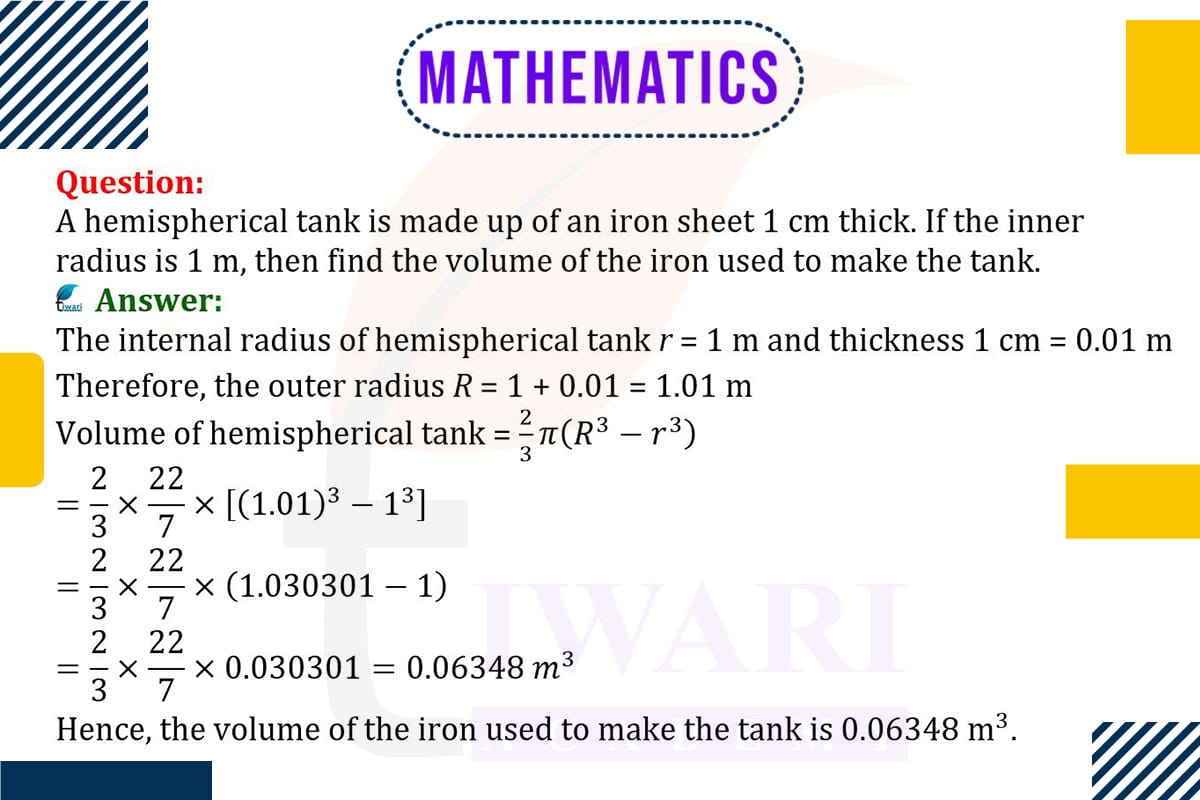To find the volume of iron used to make a hemispherical tank, we need to calculate the volume of the outer hemisphere minus the volume of the inner hemisphere. The inner radius of the tank is 1 m, and the thickness of the iron sheet is 1 cm (0.01 m). Therefore, the outer radius is 1 m + 0.01 m = 1.01 m.
The volume of a hemisphere is given by V = (2/3)πr³.
The volume of the outer hemisphere is V(o) = (2/3)π × 1.01³ m³, and
The volume of the inner hemisphere is V(i) = (2/3)π × 1³ m³.
The volume of the iron used is V(o) − V(i).
This calculation gives the volume of iron required to construct the hemispherical tank, taking into account the thickness of the iron sheet.

Let’s discuss in detail
Volume Calculation in Material Fabrication
The calculation of the volume of materials used in fabrication is a critical aspect of manufacturing and engineering. In the case of a hemispherical tank made from an iron sheet, understanding how to calculate the volume of iron used is essential for cost estimation, resource allocation, and design purposes. This problem involves applying concepts of solid geometry to a real-world object, demonstrating the practical application of mathematical principles in industrial design and manufacturing.
Understanding the Structure of a Hemispherical Tank
A hemispherical tank is a half-sphere, and its construction involves shaping iron sheets into this form. The tank in question has an inner radius of 1 meter, and the iron sheet used to make it is 1 cm thick. This thickness is crucial as it adds to the overall dimensions of the tank, affecting the volume of material used. The outer radius of the tank is therefore larger than the inner radius by the thickness of the iron sheet.
Calculating the Outer Radius of the Tank
To calculate the volume of iron used, it’s necessary first to determine the outer radius of the tank. The outer radius is the sum of the inner radius and the thickness of the iron sheet. Given that the inner radius is 1 meter and the iron sheet is 1 cm thick (which is 0.01 meters), the outer radius is 1 meter + 0.01 meters = 1.01 meters. This outer radius is used to calculate the volume of the outer hemisphere of the tank.
Volume Calculation of the Outer Hemisphere
The volume of a hemisphere is given by the formula V = (2/3)πr³. Applying this formula to the outer hemisphere with a radius of 1.01 meters, the volume of outer is calculated as V(o) = (2/3)π × 1.01³ m³. This represents the total volume of the tank including the iron sheet’s thickness.
Volume Calculation of the Inner Hemisphere
Similarly, the volume of the inner hemisphere (the actual storage space of the tank) is calculated using the inner radius of 1 meter. Applying the same formula, V(i) = (2/3)π × 1³ m³. This volume represents the space inside the tank that can hold a substance, such as water.
Determining the Volume of Iron Used
The volume of iron used in the construction of the tank is the difference between the outer and inner hemispheres’ volumes. By subtracting the inner volume from the outer volume V(iron) = V(o) – V(i), we obtain the volume of the iron sheet used to construct the tank. This calculation is crucial for understanding the amount of material needed for the tank’s construction and is a practical application of geometric principles in industrial manufacturing.
In conclusion, calculating the volume of iron used in the construction of a hemispherical tank illustrates the intersection of geometry and industrial design. This process is essential in the manufacturing sector for material estimation and cost analysis. Understanding these concepts allows for efficient planning and resource management, highlighting the importance of geometry in practical scenarios.
Discuss this question in detail or visit to Class 9 Maths Chapter 11 for all questions.
Questions of 9th Maths Exercise 11.4 in Detail

